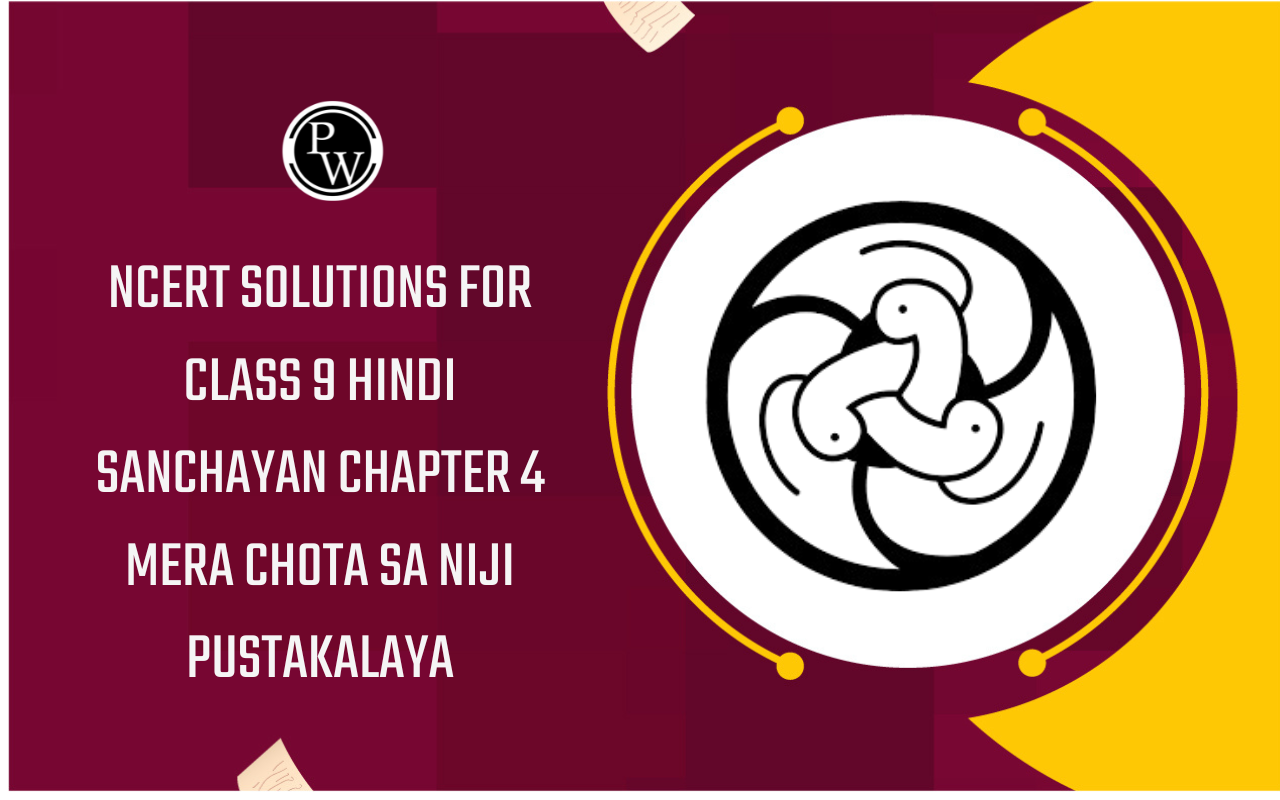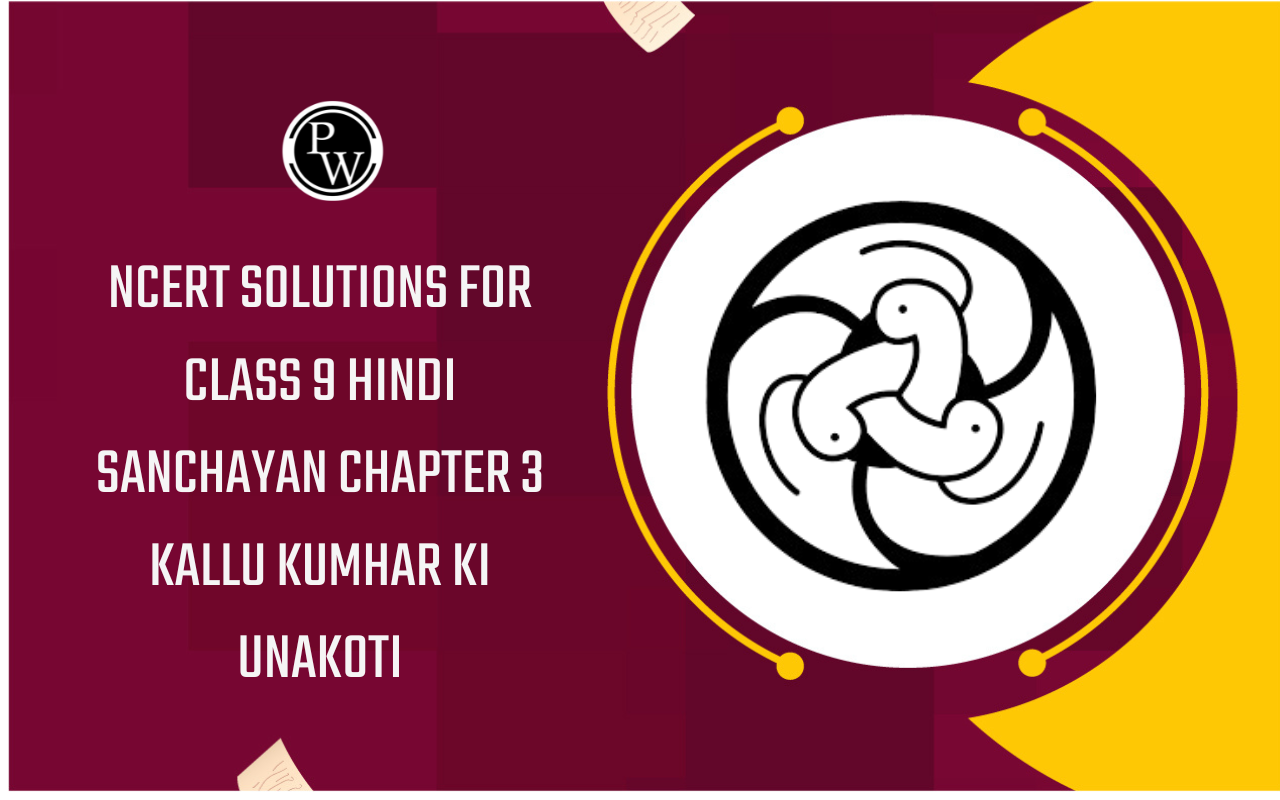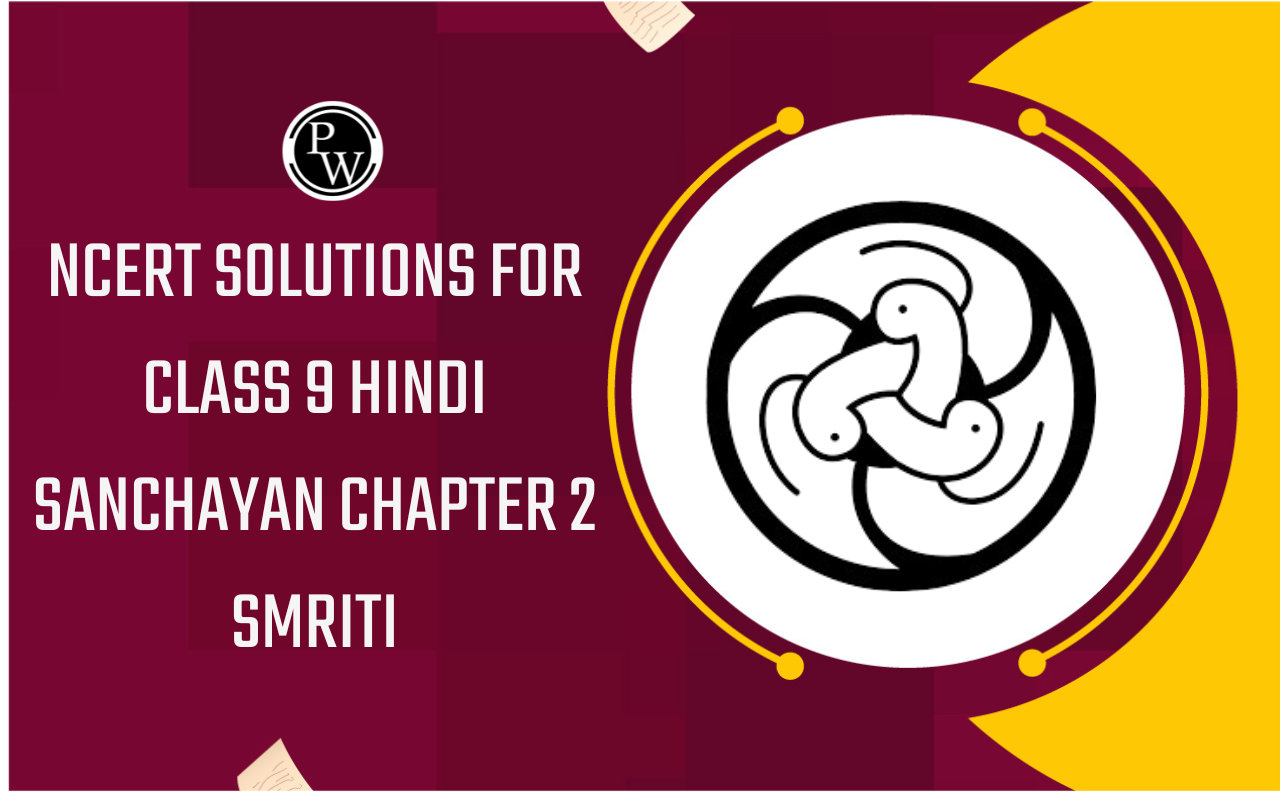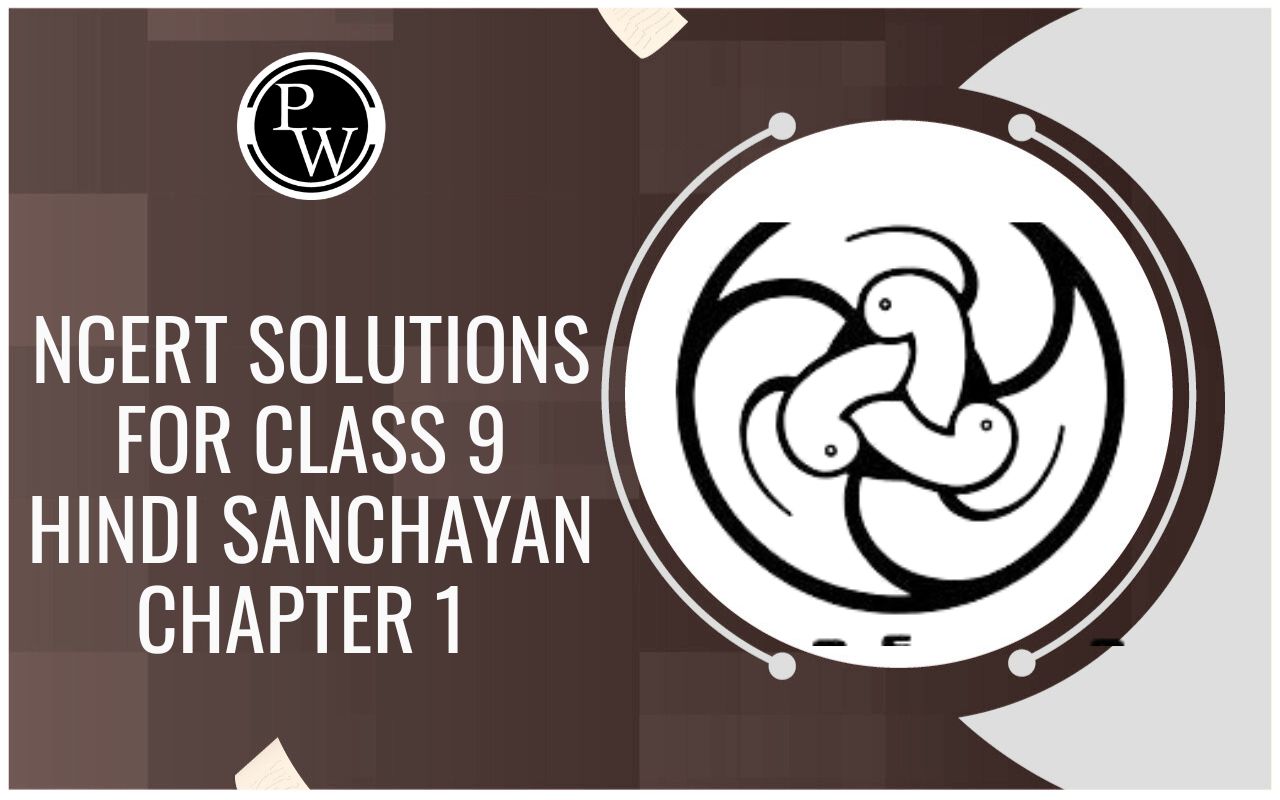
NCERT Solutions For Class 11 Maths chapter-9 Sequences And Series Miscellaneous Exercise
NCERT Solutions for Class 11 Maths Chapter-9 Sequences and Series
Academic team of Physics Wallah developed step by step
NCERT Solutions For Class 11 Maths
Chapter-9 Sequences and Series Miscellaneous Exercise according to recommen dations and Guideline of CBSE. You can download solution of all chapters from Physics Wallah
NCERT solutions
of class 11.
NCERT Solutions for Class 11 Maths Miscellaneous Exercise
Question
1. Show that the sum of (m+n)
th
and (m–n)
th
terms of an A.P. is equal to twice the m
th
term.
Solution :
Let the first term of the A.P. be a
and the common difference be d
.
The term of an A.P. is given by the equation
a
k
= a+(k−1)d
Therefore,
a
m+n
= a+(m+n−1)d
a
m+n
= a+(m−n−1)d
a
m
= a+(m−1)d
Add a
m+n
and a
m-n
a
m+n
+ a
m-n
= a+(m+n−1)d+a+(m−n−1)d
=2a+(m+n−1+m−n−1)d
=2a+(2m−2)d
=2a+2(m−1)d
=2[a+(m−1)d]
=2a
m
Therefore, the sum of (m+n)
th
and (m−n)
th
terms of an A.P. is equal to twice the mth term is proved.
Question
2. If the sum of three numbers in A.P., is 24 and their product is 440. Find the numbers.
Solution :
Let a−d , a and a+d be the three numbers in A.P. According to the conditions given in the question,
(a−d)+(a)+(a+d)=24
⇒ 3a=24
⇒a=8
(a−d) + (a) + (a+d) = 440
Substituting a=8 in the equation.
(8−d)(8)(8+d)=440
⇒(8−d)(8+d)=55
⇒64−d2 = 55
⇒d2 = 64−55
⇒d2 = 9
⇒d =±3
When d = 3 the three numbers are 5,8 and 11 When d=−3 the three numbers are 11,8 and 5
Therefore, 5,8 and 11 are the three numbers.
Question
3. Let the sum of n,2
n
,3
n
terms of an A.P. be S
1
,S
2
,S
3
, respectively, show that S
3
=3(S
2
−S
1
)
Solution :
Let the first term of the A.P. be a and the common difference be d
The sum of first n terms of an arithmetic progression is given by the equation…..
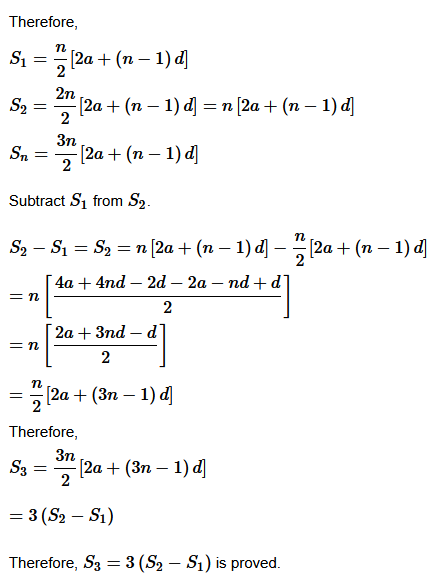
Question
4. Find the sum of all numbers between 200 and 400 which are divisible by 7.
Solution :
203,210,217,...,399 are the numbers lying between 200 and 400 , which are divisible by 7 An A.P. is formed by this series.
The first term of the A.P. is a=203, the last term is an=399 and the common difference is d=7
The nth term of the A.P. is given by the equation an=a+(n−1)d
.Therefore, a+(n−1)d=399
Substitute a=203
and d=7
in the equation.
⇒203+(n−1)7=399
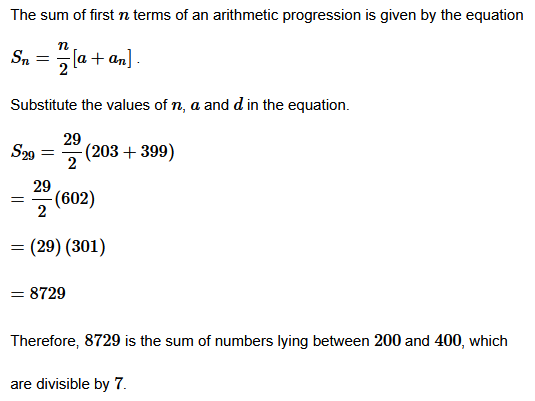
The sum of first n
terms of an arithmetic progression is given by the equation
Question
5. Find the sum of integers from 1 to 100 that are divisible by 2 or 5.
Solution :
Given: A.P. which is divisible by 2
2, 4, 6, ………., 100
2,4,6,...100 are the integers lying between 1 to 100 , which are divisible by 2 . An A.P. is formed by this series.
The first term of the A.P. and the common difference is equal to 2 The nth term of the A.P. is given by the equation a
n
= a+(n−1)d
Substitute a = 2 and d = 2 in the equation.
⇒100 = 2+(n−1)
2
⇒n=50
The sum of first n terms of an arithmetic progression is given by the equation

Substitute the values of n , a and d in the equation.
2+4+6+...+100=50/2[2(2)+(50−1)(2)]
=50/2(4+98)
=(25)(102)
=2550
5,10,...100
are the integers lying between 1
to 100
, which are divisible by 5
. An A.P. is formed by this series.
The first term of the A.P. and the common difference is equal to 5 The n
th
term of the A.P. is given by the equation a
n
= a+(n−1)d
.
Substitute a=5
and d=5
in the equation.
⇒100=5+(n−1)5
⇒5n=100
⇒n=20
The sum of first n terms of an arithmetic progression is given by the equation

Substitute the values of n, a and d in the equation.
5+10+...+100 = 20/2[2(5)+(20−1)5]
=10[10+(19)5]
=10[10+95]
=10×105
=1050
10,20,...100
are the integers lying between 1 to 100 , which are divisible by 2 and 5
. An A.P. is formed by this series. The first term of the A.P. and the common difference is equal to 10
The nth term of the A.P. is given by the equation
a
n
=a+(n−1)d
.Substitute a=10 and d=10
in the equation.
⇒100=10+(n−1)10
⇒100=10n
⇒n=10
The sum of first n
terms of an arithmetic progression is given by the equation

.
Substitute the values of n
, a
and d
in the equation.
10+20+...+100=102[2(10)+(10−1)(10)]
=5[20+90]
=5(110)
=550
Therefore,
2250+1050−550=3050
Question
6. Find the sum of all two digit numbers which when divided by 4, yield 1 as remainder.
Solution :
Given: A.P. 13, 17, 21, ………., 97
Now
13,17,...97 are the two-digit numbers which when divided by 4
yields 1
as remainder. An A.P. is formed by this series.
The first term of the A.P. is a=13
, the last term is an=97
and the common difference is d=4
.
The nth
term of the A.P. is given by the equation an=a+(n−1)d
.
Substitute a=13
and d=4
in the equation.
⇒97=13+(n−1)4
⇒4(n−1)=84
⇒n−1=21
⇒n=22
The sum of first n
terms of an arithmetic progression is given by the equation

Substitute the values of n, a and d in the equation.
S
22
=22/2[2(13)+(22−1)(4)]
=11[26+84]
=1210
Therefore, 1210
is the sum of all two-digit numbers which when divided by 4
, yields 1 remainder
Question
7. If f is a function satisfying f (x +y) = f(x) f(y) for all x, y ∈ N such that f(1)= 3 and
 = 120, find the value of n.
= 120, find the value of n.
Solution :
According to the given conditions in the question,
f(x+y) = f(x)×f(y) for all x,y,∈N
f(1) = 3
Let x = y = 1
Then,
f(1+1) = f(1+2) = f(1)f(2) = 3 × 3 =9
We can also write
f(1+1+1) = f(3) = f(1+2) = f(1)f(2) = 3×9 = 27
f(4)= f(1+4) = f(1)f(3) = 3×27 = 81
Both the first term and common ratio of f(1),f(2),f(3),...,that is 3,9,27,...,
that forms s G.P. is equal to 3
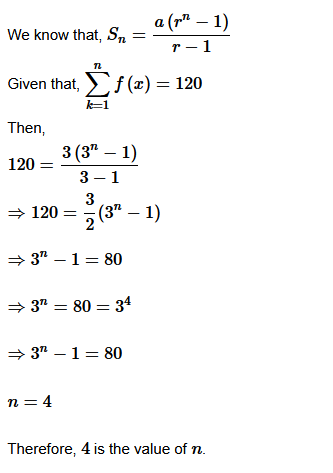
Question
8. The sum of some terms of G.P. is 315 whose first term and the common ratio are 5 and 2 respectively. Find the last term and the number of terms.
Solution :
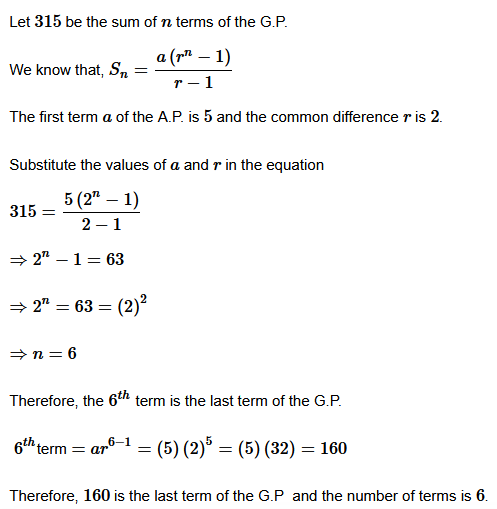
Question
9. The first term of a G.P. is 1. The sum of the third term and fifth term is 90. Find common ratio of G.P.
Solution :
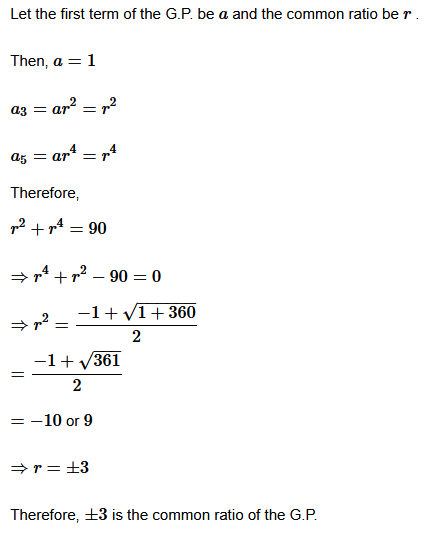
Question
10. The sum of three numbers in G.P. is 56. If we subtract 1, 7, 21 from these numbers in that order, we obtain an arithmetic progression. Find the numbers.
Solution :
Let a,ar and ar
2
be the three numbers in G.P. According to the conditions given in the question,
a+ar+ar
2
= 56
⇒a(1+r+r
2
)=56 …(1)
An A.P. is formed by
a−1,ar−7,ar
2
−21
Therefore,
(ar−7)−(a−1) = (ar
2
−21)−(ar−7)b
⇒ar−a−6 = ar
2
−ar−14
⇒ar
2
−2ar+a = 8
⇒ar
2
−ar−ar+a= 8
⇒a(r
2
+1−2r)=8
⇒a(r
2
−1)2=8
…(2)
Equating (1) and (2), we get
⇒7(r
2
−2r+1)=1+r+r2
⇒7r
2
−14r+7−1−r−r2
⇒6r
2
−15r+6=0
⇒6r
2
−12r−3r+6=0
⇒6(r−2)−3(r−2)=0
⇒(6r−3)(r−2)=0
Then,8,16 and 32 are the three numbers when r=2
and 32,16 and 8 are the numbers when r=12
.
Question
11. A G.P. consists of an even number of terms. If the sum of all the terms is 5 times the sum of terms occupying odd places, then find its common ratio.
Solution :
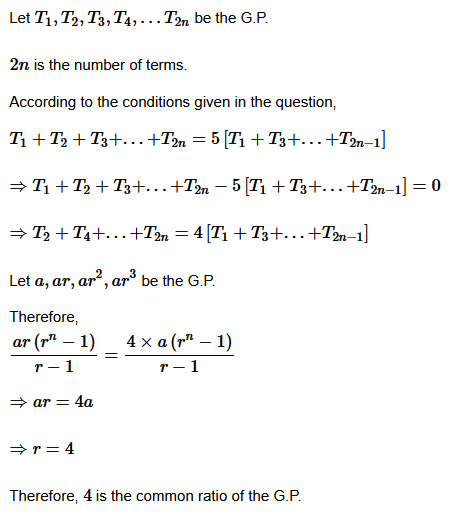
Question
12. The sum of the first four terms of an A.P. is 56. The sum of the last four terms is 112. If its first term is 11, then find the number of terms.
Solution :
Let a,a+d,a+2d,a+3d...a+(n−2)d,a+(n−2)d
be the A.P.
a(a+d)+(a+2d)+(a+3d)=4a+6d
is the sum of the first four terms.
[a+(n−4)d]+[a+(n−3)d]+[a+(n−2)d]+[a+(n−1)d]=4a+(4n−10)d
is the sum of the last four terms.
According to the conditions given in the question,
4a+6d=56
It is given that a=11
, then
⇒4(11)+6d=56
⇒6d=12
⇒d=2
Therefore,
4a+(4n−10)d=112
⇒4(11)+(4n−10)2=112
⇒(4n−10)2=68
⇒4n−10=34
⇒4n=44
⇒n=11
Therefore, 11
is the number of terms of the A.P.
Question
13. If
 then show that a,b,c and d are in G.P.
then show that a,b,c and d are in G.P.
Solution :
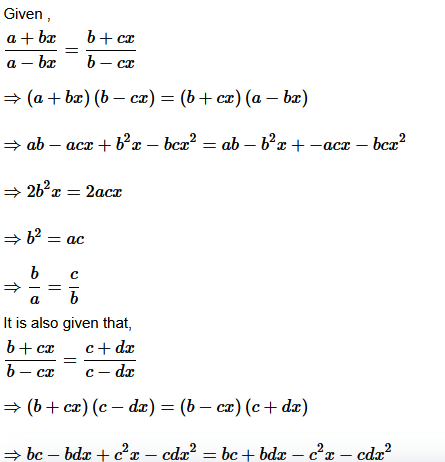
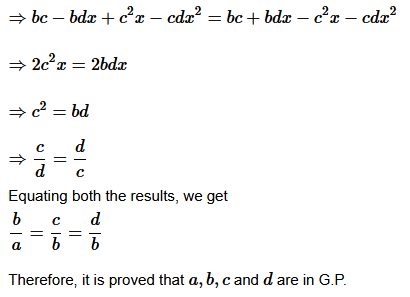
Question 14. Let S be the sum, P the product and R the sum of reciprocals of n terms in a G.P. Prove that P 2 R n = S n
Solution :
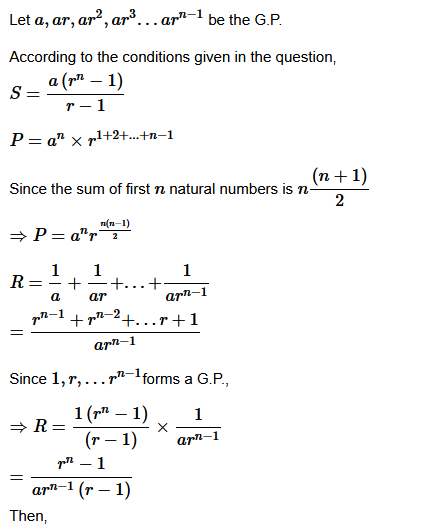
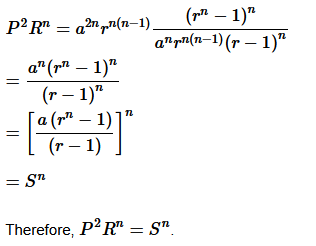
Proved.
Question
15: The p
th
,q
th
and r
th
terms of an A.P. are a, b, c, respectively. Show that (q – r )a + (r – p )b + (p – q )c = 0
Solution :
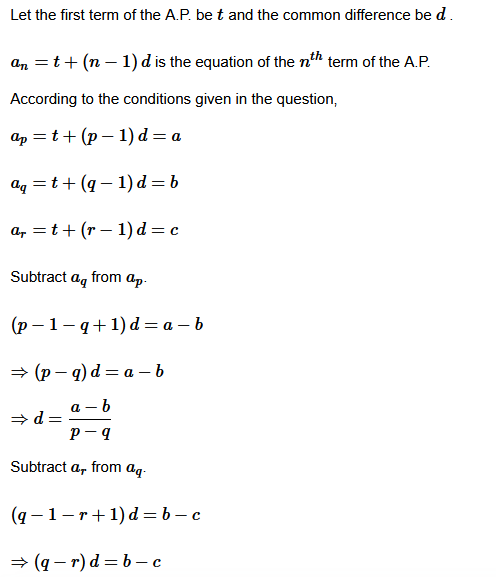
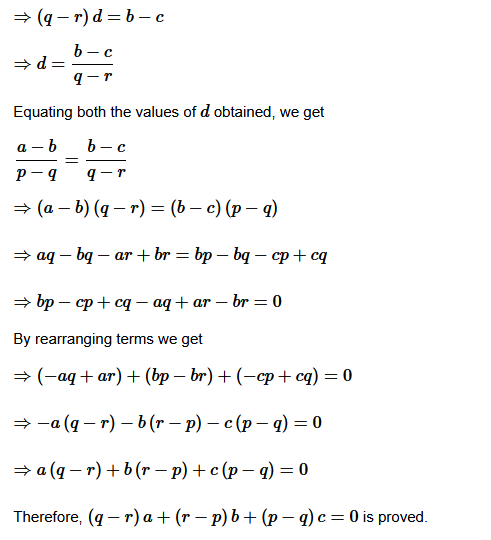
Question
16. If
 are in A.P., prove that
a , b ,c
are in A.P.
are in A.P., prove that
a , b ,c
are in A.P.
Solution :
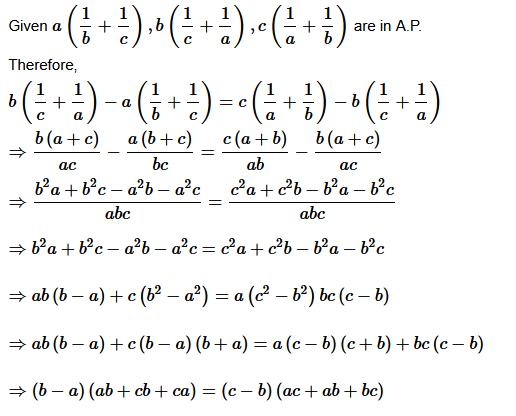
Question
17. If a, b, c, d are in G.P, prove that (a
n
+ b
n
),(b
n
+ c
n
),(c
n
+ d
n
) are in G.P.
Solution :
Given:
a, b, c, d
are in G.P.
b
2
= ac
c
2
= bd
ad = bc
To prove:
(a
n
+ b
n
),(b
n
+ c
n
),(c
n
+ d
n
)
are in G.P.
That is, (b
n
+ c
n
)
2
= (a
n
+ b
n
),(c
n
+ d
n
)
Then,
L.H.S =(b
n
+ c
n
)
2
=b
2
n+2b
n
c
n
+c2
n
=(b
2
)n+2b
n
c
n
+(c
2
)n
=(ac)
n
+2b
n
c
n
+(bd)
n
=a
n
c
n
+b
n
c
n
+b
n
c
n
+b
n
d
n
=a
n
c
n
+b
n
c
n
+a
n
d
n
+b
n
d
n
=c
n
(a
n
+b
n
)+d
n
(a
n
+b
n
)
=(a
n
+b
n
)(a
n
+d
n
)
=
R.H.S
Therefore,
(b
n
+c
n
)
2
=(a
n
+b
n
)(c
n
+d
n
)
Therefore, (b
n
+c
n
),(b
n
+c
n
)
and (c
n
+d
n
)
are in G.P.
Question
18. If a and b are the roots of x
2
− 3x + p = 0 and c, d are roots of x
2
−12x + q= 0 where a,b,c,d form a G.P.Prove that (q+p) : (q−p)= 17:15.
Solution :
Given: a
and b
are the roots of x
2
− 3x + p =0
.Therefore,
a + b = 3 and ab=p …(1)
We also know that c and d
are the roots of x2−12x+q=0
.Therefore,
c+d=12 and cd=q …(2)
Also, a,b,c,d are in G.P.
Let us take a=x, b=xr, c=xr
2
and d=xr
3
.
We get from (1) and (2) that,
x+xr = 3
⇒ x(1+r) =3
Also,
xr
2
+ xr
3
= 12
⇒xr
2
+ (1+r) = 12
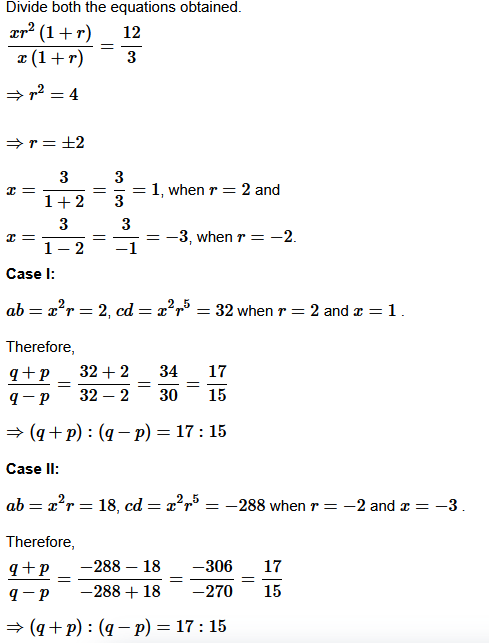
Therefore, Therefore, it is proved that (q+p):(q−p) = 17:15as we obtain the same for both the cases.
Question
19. The ratio of the A.M. and G.M. of two positive numbers
a
and
b
is
m : n
Show that a : b =

Solution :
Given:
a : b =

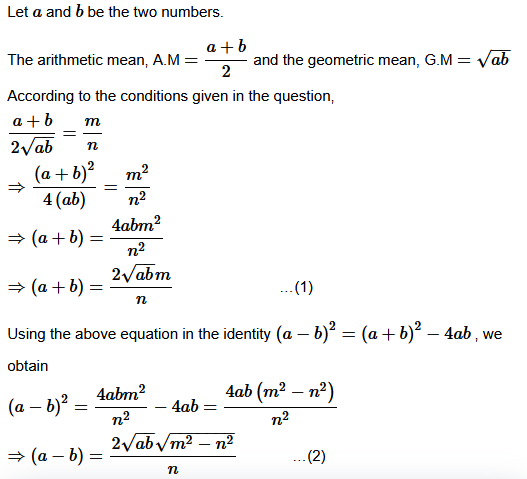
By component and dividend,
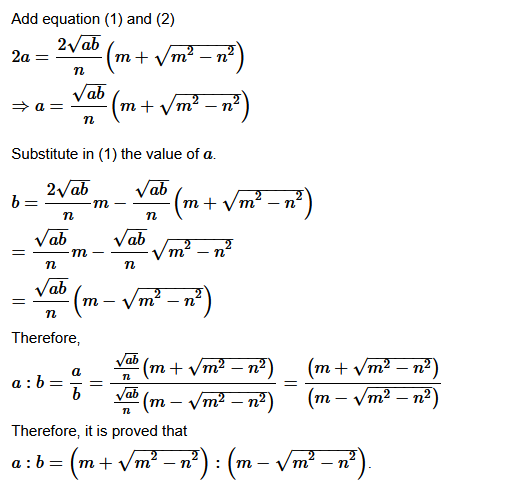
Question
20. If a, b, c are in A.P.; b, c, d are in G.P. and 1/c,1/d,1/e are in A.P. prove that a, c, e are in G.P.
Solution :
Since,
Given a,b,c are in A.P.Therefore, b−a=c−b are in A.P.
⇒ 2b = a + c
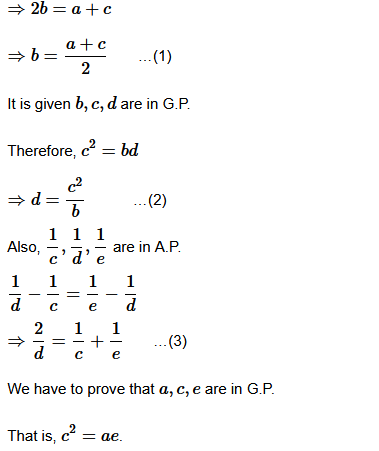
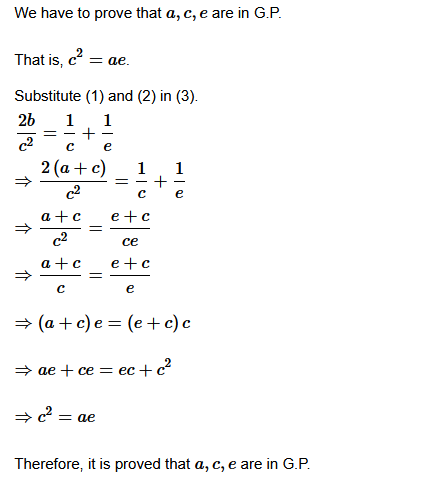
Question
21. Find the sum of the following series up to n terms:
(i) 5 + 55 + 555 + ……….
(ii) .6 + .66 + .666 + ………….
Solution :
(i) s
n
= 5 + 55 + 555 + ………. up to n terms
= 5/9 [1 + 11 + 111 + ………. up to n terms]
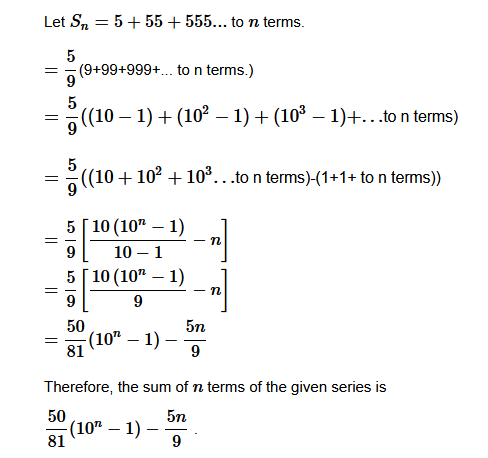
(ii) s
n
= .6 + .66 + .666 + …………. up to n terms
= 6 [.1 + .11 + .111 + ………. up to n terms]
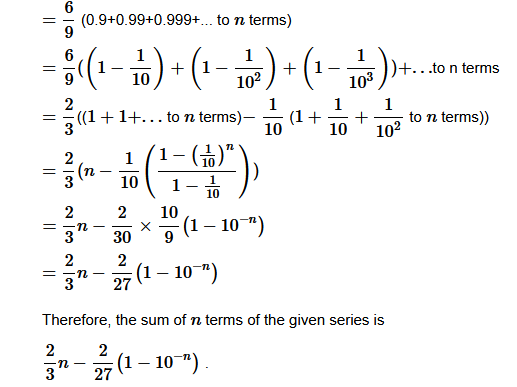
Question
22. Find the 20
th
term of the series 2 × 4 + 4 × 6 + 6 × 8 + ... + n terms.
Solution :
Given:
2 × 4 + 4 × 6 + 6 × 8 + ... + n
terms
Therefore the nth term an=2n×(2n+2)=4n2+4n
Then,
a
20
=4(20)
2
+ 4(20)
=4(400)+80
=1600+80
=1680
Therefore, 1680
is the 20
th
Question
23. Find the sum of the first n terms of the series: 3 + 7 + 13 + 21 + 21 + ……….
Solution :
Given:
3 + 7 + 13 + 21 + 21 + ………
……….(i)
Also 3+7+13+21+31+...
is the given series.
S=3+7+13+21+31+...+a
n−1
+ a
n
S=3+7+13+21+...+ a
n−2
+ a
n−1
+ a
n
……….(ii)
Subtracting eq. (ii) from eq. (i),
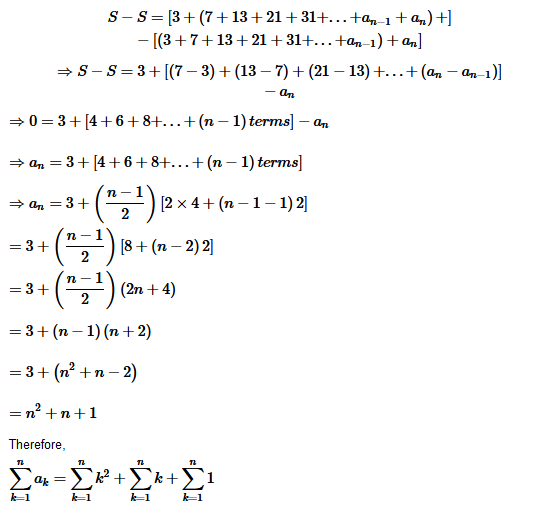
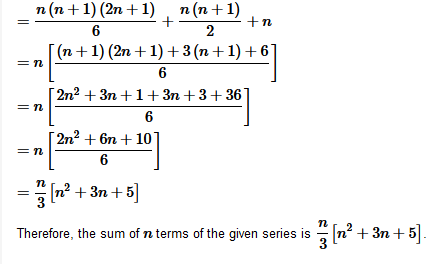
Question
24. If S1,S2,S3 are the sum of first n natural numbers, their squares and their cubes, respectively, show that 9S
2
2
= S
3
(1+8S
1
)
Solution :
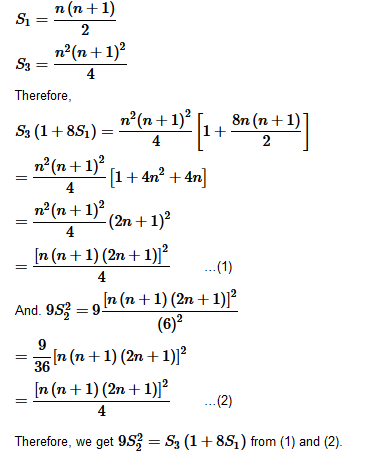
Question
25. Find the sum of the following series up to n terms:

Solution :
Given:
 up to n
th
terms
up to n
th
terms
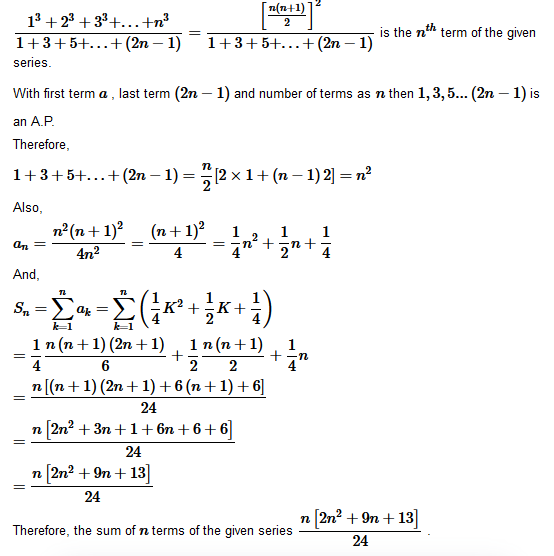
Question
26. Show that

Solution :
Given:

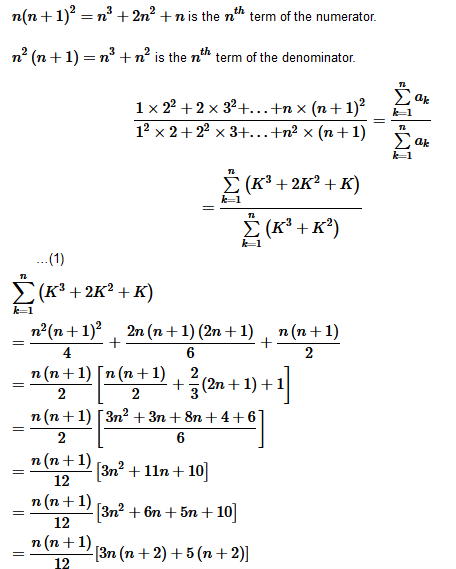
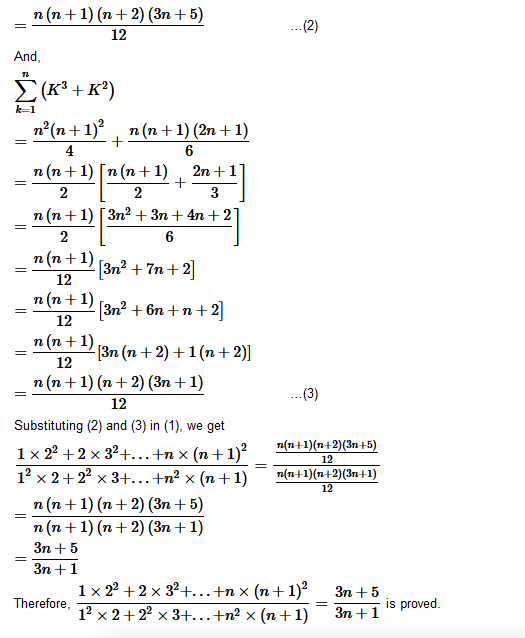
Question
27. A farmer buys a used tractor for Rs. 12000. He pays Rs. 6000 cash and agrees to pay the balance in annual installments of Rs. 500 plus 12% interest on the unpaid amount. How much will the tractor cost him?
Solution :
It is given that Rs.6000
is paid in cash by the farmer.
Therefore, the unpaid amount is given by
Rs.12000−Rs.6000 = Rs.6000
According to the conditions given in the question, the interest to be paid annually by the farmer is
12 of 6000 , 12 of 5500 , 12 of 5000...12 of 500
Therefore, the total interest to be paid by the farmer
=12 of 6000+12 of 5500+12 of 5000+...+12 of 500
=12 of (6000+5500+5000+...+500)
=12 of (500+1000+1500+...+6000)
With both the first term and common difference equal to 500
, the series 500,1000,1500...6000 is an A.P.
Let n
be the number of terms of the A.P.
Therefore,
6000=500+(n−1)500
⇒1+(n−1)=12
⇒n=12
Therefore, the sum of the given A.P.
=122[2(500)+(12−1)(500)]
=6[1000+5500]
=6(6500)
=39000
Therefore, the total interest to be paid by the farmer
=12 of (500+1000+1500+...+6000)
=12 of Rs.39000
= Rs.4680
Therefore, the total cost of tractor
= (Rs.12000+ Rs.4680 )
= Rs.16680
Therefore, the total cost of the tractor is Rs.16680
Question
28. Shams had Ali buys a scooter for Rs. 22000. He pays Rs. 4000 cash and agrees to pay the balance in annual installment of Rs. 1000 plus 10% interest on the unpaid amount. How much will the scooter cost him?
Solution :
It is given that for Rs.22000 Shamshad Ali buys a scooter and Rs.4000
is paid in cash. Therefore, the unpaid amount is given by
Rs.22000−Rs.4000 = Rs.18000
According to the conditions given in the question, the interest to be paid annuallyis
10 of 18000 , 10 of 17000, 10 of 16000...10 of 1000
Therefore, the total interest to be paid by the farmer
=10 of 18000+10 of 17000+1 of 16000+...+10 of 1000
=10 of (18000+17000+16000+...+1000)
=10 of (1000+2000+3000+...+18000)
With both the first term and common difference equal to 1000
, the series 1000,2000,3000...18000 is an A.P.
Let n be the number of terms of the A.P.
Therefore,
18000=1000+(n−1)1000
⇒1+(n−1)=18
⇒n=18
Therefore, the sum of the given A.P.
=18/2 [2(1000)+(18−1)(1000)]
=9[2000+17000]
=9(19000)
=171000
Therefore, the total interest to be paid
=10 of (18000+17000+16000+...+1000)
=10 of Rs.171000
=
Rs.17100
Therefore, the total cost of scooter
=
(Rs.22000 + Rs.17100)
=
Rs.39100
Therefore, the total cost of the scooter is Rs.39100
Question
29. A person writes a letter to four of his friends. He asks each one of them to copy the letter and mail to four different persons with instruction that they move the chain similarly. Assuming that the chain is not broken and that it costs 50 paise to mail one letter. Find the amount spent on the postage when 8th set of letter is mailed.
Solution :
=
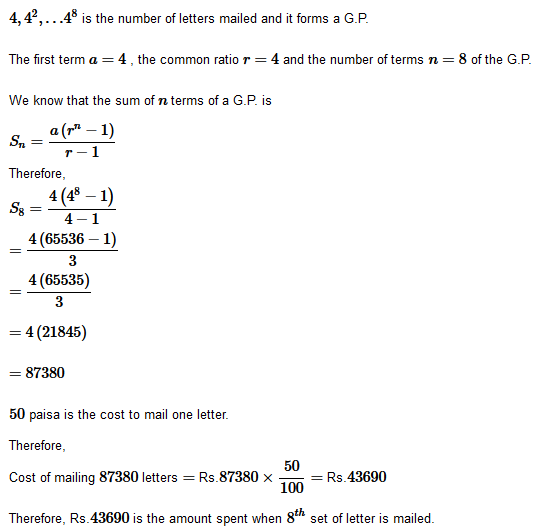
Question
30. A man deposited Rs. 10000 in a bank at the rate of 5% simple interest annually. Find the amount in 15th year since he deposited the amount and also calculate the total amount after 20 years.
Solution :
Rs.10000 is deposited by the man in a bank at the rate of 5 simple interest annually
=5/ 100 × Rs.10000 = Rs.500
Therefore,
10000+500+500+...+500 is the interest in 15th
year. (500 is 14 added times)
Therefore, the amount in 15th
year = Rs.10000+14 × Rs.500
= Rs.10000 + Rs.7000
= Rs.17000
Rs.10000+500+500+...+500
is the amount after 20 years. (500 is 20 added times)
Therefore, the amount after 20
years = Rs.10000+20 × Rs.500
= Rs.10000 + Rs.10000
=
Rs.20000
The total amount after 20 years is Rs.20000
Question
31. A manufacturer reckons that the value of a machine, which cost him Rs. 15625 will depreciate each year by 20%. Find the estimated value at the end of 5 years.
Solution :
The cost of the machine is Rs.15625.
Every year machine depreciates by 20.
Therefore, 80 of the original cost ,i.e., 45 of the original cost is its value after every year.
Therefore, the value at the end of 5 years
=15626×45×45×...×45
=5×1024
=5120
Therefore, Rs.5120
is the value of the machine at the end of 5
years.
Question
32. 150 workers were engaged to finish a job in a certain number of boys. 4 workers dropped out on second day, 4 more workers dropped out on third day and so on. It took 8 more days to finish the work find the number of days in which the work was completed.
Solution :
Let the number of days in which 150 workers finish the work be x
.According to the conditions given in the question,
150x=150+146+142+...(x+8)
terms
With first term a=146, common difference d=−4 and number of turns as (x+8) , the series 150+146+142+...(x+8)
terms is an A.P.
⇒150x=(x+8)/2[2(150)+(x+8−1)(−4)]
⇒150x=(x+8)[150+(x+7)(−2)]
⇒150x=(x+8)(150−2x−14)
⇒150x=(x+8)(136−2x)
⇒75x=(x+8)(68−x)
⇒75x=68x−x2+544−8x
⇒x2+75x−60x−544=0
⇒x2+15x−544=0
⇒x2+32x−17x−544=0
⇒x(x+32)−17(x+32)=0
⇒(x−17)(x+32)=0
⇒x=17
or x=−32
We know that x cannot be negative.
So, x=17
Therefore, 17
is the number of days in which the work was completed. Then the required number of days =(17+8)=25
.






